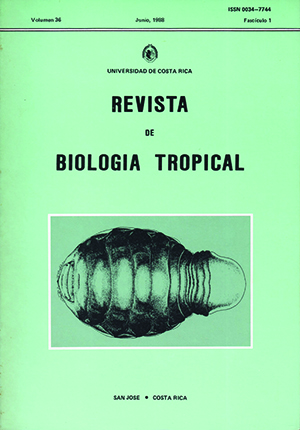Abstract
Cedrela odorata L. is a deciduous tree 30-35 m height and 1.5 m in diameter, native to Costa Rica, which grows in areas ranging from 1500-3000 m.s.n.m.
The wood has coarse and heterogeneous texture, linear grain and superposed areas in tangential section with 2-4 growth rings 12.5 cm. Porosity is diffuse, circular or semicircular. There is variation in pore size, vessel element length, fiber length, cell wall thickness of fibers and ray composition between specimens collected at different localities. Runkel factor corresponds to Group IV, regular for pulp production; however, the physical and mechanical characteristics show the wood to be excellent for building and cabinetwork.
References
Acosta, M. 1954. El cedro centroamericano en el Ecuador, Cedrela mexicana Roemer. Instituto Ecuatoriano de Ciencias Naturales No. 5, Ecuador. 16 p.
Fujichira Industry. 1965. The standard Soil Color Chart. Nippon Shikisaisha, Japón. 149p.
González, M. & G. González. 1973. Propiedades físicas, mecánicas, usos y otras características de algunas maderas comercialmente importantes en Costa Rica. Parte ll, Costa Rica. 51 p.
Haris, G. (sin fecha). Características generales macroscópicas y microscópicas de .113 especies panameñas. Parte ll, Panamá. 453 p.
Jane, F. 1970. The structure of wood. Adam & Charles Black, Londres. 444 p.
Johansen, D. 1940. Plant microtechnique. Mac Graw Hill Book, Nueva York. 523 p.
Lamb, A. 1969. Especies maderables de crecimiento rápido en la tierra baja tropical. Cedrela odorata L. Instituto Forestal Latinoamericano de Inve.stigación-Capación, Venezuela, Boletín No. 31-31, p. 15-59.
Lens Key. 1960. ldentification of Hodwoods (sin. paginación).
Llach, L. (sin fecha) Propiedades físicas y mecánicas de 113 especies panameñas. Parte III, Panamá, p. 499-501.
Mendieta, R. & Silvia del Amo. 1981. Plantas medicinales del Estado de Yucatán. Instituto Nacional de Investigación sobre Recursos Bióticos. Compañía Editorial Continental, México, p. 90.
Moseley, M. & R. Beeks. 1955. Studies ofthe Garryaceae. I. The comparative morphology and phylogeny. Phytomorph. 5: 314-346.
Pérez, S.; A. Alvarado & E. Ramírez. 1978. Asociaciones de subgrupos de suelos de Costa Rica. Escala 1:200,000.
Record, S. & R. Hess. 1949. Timbers of the New World. Yale University Press, Londres, p. 359-374.
Roig, J. 1935. El cedro. Estudio botánico agrícola. Estación agronómica, Cuba. 31 p.
Ronald, M. 1974. The geograph of the flowering plants. Longmans, Nueva York, p. 201.
Runkel, R. 1952. Pulp from Tropical Wood. Tappi 35:174-178.
Smith, C. 1959. The species of Cedrela (Meliaceae), p. 368. In International Botanical Congress. -9 thMontreal, 1959 (Proceedings, Ottawa, Vol. II).
Smith, C. 1960. A revision of Cedrela (Meliaceae). Field. Bot. 29: 295-317.
Styles, B. 1981. Swietenioideae, p. 359-394. In Pennington. T.; B. Styles y D. Taylor (Eds.). Flora Neotropica. Monograph No. 28.
Tosi, J. 1979. Mapa ecológico, basado en zonas de vida. Costa Rica. Escala 1:750000.
##plugins.facebook.comentarios##

This work is licensed under a Creative Commons Attribution 4.0 International License.
Copyright (c) 1988 Revista de Biología Tropical


